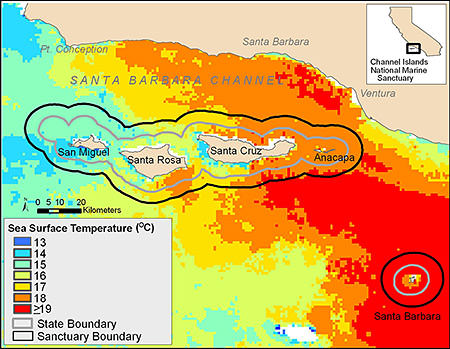Climate Change and Ocean Acidification
Channel Islands

Why is it a concern?
Human-induced increases in greenhouse gas emissions are contributing to global-scale warming and are associated with acidification of the worlds oceans. Climate change is projected to profoundly affect coastal and marine ecosystems on a global scale, and the Channel Islands sanctuary is expected to manifest the consequences as well. The Channel Islands are at a transition zone between cold northern currents and warm southern currents. Changes in that boundary driven by large-scale climate alteration can change the marine community as a result of habitat changes and shifts in species ranges. Furthermore, climate change could affect species through changes in phenology and disease ecology. For example, reproductive performance of the seabird species, Cassins Auklets, may be affected by oceanographic conditions and prey availability during breeding seasons and alterations due to climate change may exacerbate these conditions. In addition, although the red abalone population at San Miguel Island does not exhibit symptoms of withering syndrome, a marine disease, at least half of the population harbors the infectious bacterium responsible for the disease . It appears that the symptoms are more prevalent in populations located in warmer water; therefore, increases in seawater temperature may lead to outbreaks of the disease.
The Channel Islands region is also affected locally by climatic short-time scale events such as El Niño-related sea surface temperature anomaly and upwelling variability, and decadal-scale variability such as the Pacific Decadal Oscillation. Changes in upwelling driven by climatic alteration can impact zooplankton productivity and food web integrity and have cascading effects on ecosystem health. Other possible threats from climate change include changes in ocean chemistry (for example ocean acidification) and sea level rise. The impacts are expected to be intense and widespread – particularly at the bottom of the food web where trophic processes are tightly coupled to environmental chemistry.
Overview of Research
Research conducted by Sanctuary scientists and partners provides critical information to address existing and emerging resource conservation and management issues. The Overview of Research highlights some, but not necessarily all, of the research activities completed or ongoing at the Sanctuary.
| Project Name | PI and contacts | Links |
|---|---|---|
Climate variability and the Jet stream |
CINMS |
http://channelislands.noaa.gov/research/projects.html#climatevariability |
The Channel Islands National Marine Sanctuary: Planning for Climate Change [Case study on a project of the Channel Islands National Marine Sanctuary]. |
Science Needs and Questions
- What are the human carbon inputs to the Sanctuary?
- What is the net carbon budget for the Sanctuary?
- How will resources of the sanctuary be affected by climate change?
- What is the spatial extent of the aragonite solubility surface and how is that changing?
- How would sea level change affect Sanctuary resources?
- How will changes in ocean chemistry affect resources?
- What results will global climate change have throughout biological communities?
Education and Outreach Material
Understanding Ocean Acidification website
Office of National Marine Sanctuaries Climate Change Website
References
Adams, J., J.Y. Takekawa, and H.R. Carter. 2004. Stable foraging areas and variable chick diet in Cassins auklets (Ptychoramphus aleuticus) off Southern California. Canadian Journal of Zoology. Vol 82. pp. 1578-1595.
Archer, C.L. and K. Caldeira. 2008. Historical trends in the jet streams, Geophysical Research Letters 35, L08803, doi:10.1029/2008GL033614
Bane, J.M., Y.H. Spitz, R.M. Letelier, W.T. Peterson. 2007. Jet stream intraseasonal oscillations drive dominant ecosystem variations in Oregons summertime. Proceedings of the National Academy of Sciences. 104(33)13262-13267.
Barth, J.A., B.A. Menge, J. Lubchenco, F. Chan, J.M. Bane, A.R. Kirincich,M.A. McManus, K.J. Nielsen, S.D. Pierce, and L. Washburn. 2007. Delayed upwelling alters nearshore coastal ocean ecosystems in the northern California current. PNAS March 6, 2007 vol. 104 no. 10 3719-3724
CDFG (California Department of Fish and Game). 2007. Presentation to Channel Islands National Marine Sanctuary Advisory Council Research Activities Panel, February 28, 2007. Available from CINMS.
Gittings, S.R., M. Tartt, and K. Broughton. 2013. National Marine Sanctuary System Condition Report 2013. U.S. Department of Commerce, National Oceanic and Atmospheric Administration, Office of National Marine Sanctuaries, Silver Spring, MD. 33 pp.
Hays, G.C., A.J. Richardson, C. Robinson. 2005. Climate change and marine plankton. Trends in Ecology and Evolution 20(6):337-344
Fabry, V.J., B.A. Seibel, R.A. Feely, J.C. Orr. 2008. Impacts of ocean acidification on marine fauna and ecosystem processes. ICES Journal of Marine Science 65:414–432.
Mantua N.J. and S.R. Hare. 2002. The Pacific decadal oscillation. Journal of Oceanography 58: 35-44.
McGowan, J.A., D.R. Cayan, L.M. Dorman. 1998. Climate-ocean variability and ecosystem response in the northeast Pacific. Science 281(5374):210-217.
ONMS (Office of National Marine Sanctuaries). 2009. Channel Islands National Marine Sanctuary Condition Report 2009. U.S. Department of Commerce, National Oceanic and Atmospheric Administration, Office of National Marine Sanctuaries, Silver Spring, MD. 60pp.
Raupach, M.R., G. Marland, P. Ciais, C. Le Que ́ re ́, J.G. Canadell, G. Klepper, C.B. Field. 2007. Global and regional drivers of accelerating CO2 emissions. Proceedings of the National Academy of Sciences 104(24)10288-10293

